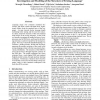Free Online Productivity Tools
i2Speak
i2Symbol
i2OCR
iTex2Img
iWeb2Print
iWeb2Shot
i2Type
iPdf2Split
iPdf2Merge
i2Bopomofo
i2Arabic
i2Style
i2Image
i2PDF
iLatex2Rtf
Sci2ools
IJDAR
2007
2007
Investigation and modeling of the structure of texting language
Language usage over computer mediated discourses, like chats, emails and SMS texts, significantly differs from the standard form of the language. An urge towards shorter message length facilitating faster typing and the need for semantic clarity, shape the structure of this non-standard form known as the texting language. In this work we formally investigate the nature and type of compressions used in SMS texts, and based on the findings develop a word level model for the texting language. For every word in the standard language, we construct a Hidden Markov Model that succinctly represent all possible variations of that word in the texting language along with their associated observation probabilities. The structure of the HMM is novel and arrived at through linguistic analysis of the SMS data. The model parameters have been estimated from a word-aligned SMS and standard English parallel corpus, through machine learning techniques. Preliminary evaluation shows that the word-model ca...
| Added | 15 Dec 2010 |
| Updated | 15 Dec 2010 |
| Type | Journal |
| Year | 2007 |
| Where | IJDAR |
| Authors | Monojit Choudhury, Rahul Saraf, Vijit Jain, Animesh Mukherjee, Sudeshna Sarkar, Anupam Basu |
Comments (0)

